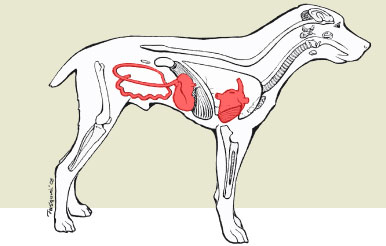Tails
Making pet parenting easy

Canine parvovirus infection in dogs
This entry was posted on 2014-07-01.
Canine parvovirus (CPV) is a highly contagious viral infection that may present in two different forms. The most common form involves the intestines and less commonly the heart; attacking the heart muscles of young puppies and most often leads to death. It is the young puppies that are most commonly affected, usually between the ages of six weeks and six months but the incidence has been dramatically reduced by early vaccination.
Symptoms and Types
The symptoms that are usually found with the intestinal form include bloody diarrhoea, loss of appetite and severe loss of weight, fever and vomiting. This viral infection often results in severe dehydration as the body is unable to absorb nutrients and fluids resulting in weakness from both the lack of fluid absorption and protein malabsorption.
Causes
The infection is caused by the canine parvovirus 2b from either direct contact with an infected dog or indirect contact through the faecal-oral route. This occurs as a large amount of the virus is found in the stool of an infected dog, and so contact of a healthy dog with the stool will result in them contracting the disease. It is quite a hardy virus, resistant to most cleaning products, weather changes and has the ability to live in ground soil for up to a year. The only disinfectant known to kill the virus is household bleach.
There are certain dog breeds that are more susceptible to the disease for unknown reasons. These include Rottweilers, Doberman Pinschers, Pit Bulls, Labrador Retrievers, German Shepherds, English Springer Spaniels, and Alaskan sled dogs.
Treatment
Treatment is usually intense and done in a hospital environment, focussing on supportive therapy as it being a viral infection means that there is no real cure. Due to the severe dehydration from the vomiting and diarrhoea, fluids given via an intravenous line may be required with additional nutritional support. Additionally, medications may be given to control the vomiting and to prevent secondary bacterial infections.
Prevention
As mentioned earlier, vaccination at a young age is the best preventative measure and advice should be sought from a veterinarian. The vaccinations are given at six, nine and twelve weeks and should not be socialised with outside dogs until at least two weeks after their last vaccination.
Living and Management
After a CPV infection, your dog will be susceptible to other disease as their immune system will be weakened. Seek guidance from your veterinarian with regard to boosting your dog’s immune system. A change in diet to one that is more easily digestible may aid in your dog’s recovery for a period after the initial infection.
It is also important to be aware that your dog is able to pass the infection on to other dogs for at least two months after the initial recovery and therefore it is important to isolate your dog from other dogs during this period of time.


